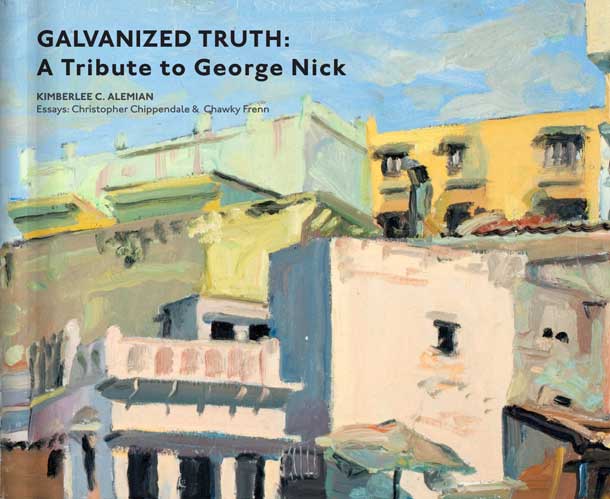
click here for a larger view
George Nick’s peers and colleagues, former students/mentee’s honor him through an exhibition of his work and their own.
at The Art Complex Museum, Duxbury, MA
May 20 – September 9, 2012
Curated by Kim Alemian.
Galvanized Truth: A Tribute to George Nick
One of my favorite essays on George Nick was written by the late John Updike in his essay titled “In Praise of George Nick” for the catalogue for Nick’s 1993 retrospective at the Mass College of Art. The closing paragraph illuminates why Nick’s teaching and art have so profoundly effected so many:
“The aesthetic and the ethical are no great distance apart, as Rilke’s tenderly phrased adoration of Cezanne suggests. Those of us lucky enough to know George in the flesh must sometimes shield our eyes against his core of blazing dedication, and smile at the elaborate apparatus of his sainthood – the famous picture-window truck, almost a Magritte fantasy in its placement of a miniature studio on wheels, once painted bright orange and now a more camouflaging green, ornamented with a martyr’s wreath of parking tickets. Cezanne and Monet, trudging out into the heat and rain with their three-legged easels, have nothing on this daily pilgrim. Rising at dawn to arrive miles distant as a certain slant of morning light befalls a chosen railroad bridge or storefront, he is nature’s acolyte; no mere coincidence has brought him to dwell in Emerson and Thoreau’s town of Concord. Dedicating himself to representation ·in the heyday of abstract expressionism, he had Fairfield Porter’s stubbornness without Porter’s family fortune. Both the serenity and harshness of the independent spirit speak in his canvases, in a mood of morning light, with most of the day still to come. The “here it is” of his paintings does not need to advertise love; love exists here not as a sentiment but as a basic condition of being.”
—John Updike
Galvanized Truth is curated by Kimberlee Alemian (former student) showing a large selection of recent work by George Nick, Several peers and colleagues, students and mentees. Artists showing include: Eric Aho, Kimberlee Alemian, Dimitri Cavander, Christopher Chippendale, Steve Cope, Jeffrey Ellse, Emily Eveleth, Jeff Fichera, Shirl Fink, Shalom Flash, Chawky Frenn, Elizabeth Gauthier, Larry Groff, Paul Inglis, Peter Inglis, Matt James, Catherine Kehoe, Ilya Lerner, Dik Liu, Kimberly MacNeille, Saeed Mahboub, Hunter McKee, Nancy Mitton, Katya Nick, Alvin Ouellet, Linda Pocheski, John Recco, Judy Solomon, Ed Stitt, and Ken Tighe. Nicks’ peers and colleagues in the exhibition include Sidney Hurwitz, Jon Imber, Janet Monafo, Richard Raiselis, Paul Rahilly, John Moore, and Graham Nickson.
The show has an excellent catalogue which is available online as an on-demand printed book. You are also able to view the entire digital version for free from this link (has reproductions of the work shown in this show) Be sure to view the book at full-screen. Kimberlee Alemian explained in the catalogue introduction:
Students clamored to gain entry to George Nick’s painting major and elective classes. Not only were his classes always filled, the majority of students were present at every session-mentally and physically. You didn’t want to miss an important piece of criticism or advice on seeing, values, color relationships, an inventive interpretation of color, composition or a myriad of constructive comments. The energy level was high with students rigorously focused on their subject. In Nick’s class painting was a very serious business. He didn’t teach a specific method or formula of painting. He taught an attitude, a way of thinking about painting—a way of seeing. Once class was over and Nick left for the day to paint his own paintings, his students continued to work on projects outside of class time. We were galvanized by George Nick.

Kimberlee Alemian, Window II, Refraction of Light, 40″ x 30″, oil on linen
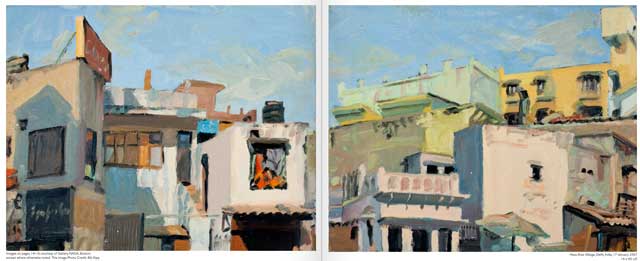
George Nick Haus Khas Village, Delhi, India, 16 x 4o inches, oil on linen January 17 2007 Photo credit: Nick Haus
George Nick teachings has been central to who I am as a painter since I first entered his classroom back in 1984, I continue to correspond and learn from him today. If you haven’t already seen it, I interviewed George Nick in a six-part series for this blog that you can read here. I was fortunate to study along with many committed and talented students. Long after our formal classes ended with George Nick several of us continued to meet in our soiree group where we revealed our latest creations to each other over pot-luck suppers. George Nick would join us, critiquing our work and often showing us his latest work as well. In 1994 there was a previous tribute show to George Nick by former students organized then by Christopher Chippendale, who now teaches at the Mass College of Art and shows at the Soprafina Gallery in Boston. I would like to thank Christopher, who is a good friend and a classmate with me, (along with Kimberlee Alemian, Emily Eveleth, Shirley Fink, Elizabeth Gauthier, Matt James, Catherine Kehoe – and others) He wrote a wonderful essay for this catalogue and gave permission to reproduce his essay in full here. The online catalogue for the show includes brief essays from each student along with images of their work. (full disclosure – I also have an essay here)
Before showing Christopher Chippendale’s essay I’d like to include some chosen quotes from the Catalogue from George Nick. Eventually I hope to add many more to this collection, if any reader recalls a quote or memory to add to this list, please contact me or leave a comment at the end of this article.
A Collection of “Nick” quotes
- “Don’t render the motif. Let cameras do that kind of work. Paint parallel to what you see”
- “That’s not dark enough.”
- “You’re being too protective of your colors. Make it darker”
- “Your colors aren’t good enough. They don’t have any feeling”
- “Forget what you know”
- “Paint in the present moment”
- “Abstract your eye from memory”
- “Do the work, regardless of what the world thinks. When people praise you and critics find faults, just focus on the work you must do.”
- “Do you know how you create, you will it!”
- “Squint to find the value structure in the motif. ”
- “Squint to distinguish between value and color.”
- “You learn how to ‘see’ by developing a keen eye for value, tone, temperature and hue; breaking down complex relationships into their basic elements”
- “You have to be disciplined.”
- “Stare at it (the surface)—really look, feel the color, the light.”
- “Drawing is the foundation of the work, you must have good drawing skills”
- “Squint to get the right value.”
- “Have you created the form in space?”
- “Always finish what you start”
- “Squint…simplify…get the relationship of tone to color”
- “Paint it, don’t fix it”
- “Don’t just fill in”
- “Don’t be afraid of putting down the wrong color.”
- “Your mistakes and chance-taking feed you”

George Nick Amphora Assya, 26 March 2000 40 x 40in oil on linen
Judging by Appearances: in praise of George Nick’s teaching
by Christopher Chippendale
It is only shallow people who do not judge by appearances. The mystery of the world is the visible, not the invisible.
—Oscar Wilde
George Nick once said that he began studying painting because he was interested in the world and painting seemed like a good way to learn about it. Conceived as such, painting was an investigative tool that, when turned outward to the world, could yield truths and meaning and an understanding of why things are the way they are. Later, as a teacher, Nick would present his students a way of thinking about painting that, while practical and concrete, was geared toward the sort of enquiry he had envisaged when he himself started painting. Based in the fluid world of perception, this way of thinking had at its core the conviction that the aesthetic and the ethical are not so far apart in painting, that knowledge comes from a search for what is right and what is truthful.
My own studies with Nick began in January of 1986. I would remain in his studio for three and a half years. I responded to the direct and concrete approach to painting that he taught in the classroom. On a personal level, I found something strangely comforting in a classroom focus engaged as directly as Nick’s was in the perceptual world. His spirited enthusiasm and openly shared appreciation of the visual world were refreshing antidotes to the overabundance of self-reflection a young person like myself was prone to at that time.
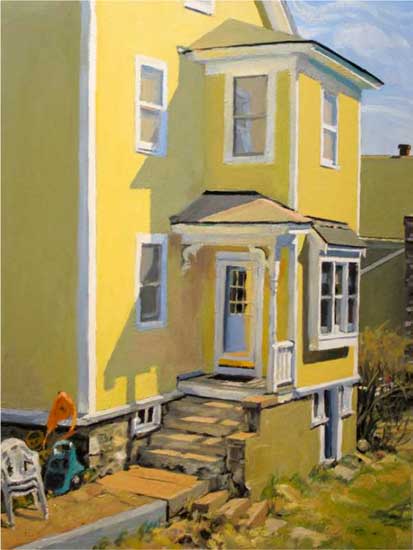
George Nick Maynard Spring, 26 March 2000 40 x 40in oil on linen
When I began my studies under Nick, I joined an already well-established legion of young artists from Massachusetts College of Art and Design who had already found themselves and their callings reified under Nick’s tutelage during his long-standing tenure at the College. By then, he had set his imprint upon the way an entire generation of young artists at Mass Art thought about painting. Several years later, in 1993, the well-known American realist painter, John Moore—then head of Graduate Painting at Boston University—heralded Nick in an open letter to the Boston Globe as: “arguably the most influential [painting] teacher in the Boston area.” The truth of Moore’s statement is even less arguable today, born out by the successful careers of many of Nick’s former students and by his lasting mark upon countless others.
In the studio, Nick guided our attention not to an interpretation of appearances, not to the personal or the analogical, but to what was there, in front of us—either on our canvases or within the motif. Surfaces were the real, and the real was the base; to which the very important qualification had to be added (as it was by Wallace Stevens) that the real was only a base.
Nick insisted that our paintings be autonomous from the world they depicted, not copies of that world. He would refer to them as separate, “parallel” constructions. “Don’t render the motif,” he would bark. “Let cameras do that kind of work. Paint parallel to what you see.” It was not copy work we were engaged in (a ‘literal’ transcription); it was translation—the motif’s materialization on the canvas through the facts both of physical paint and our own sensibilities.
Nick’s emphasis on the primacy of what could be seen—the outward manifestations of light and color and form—as distinct from the knowledge and history that could inform and adulterate what we saw, extended to his insistence on the primary function of sight. I once heard him argue, vehemently, at a graduate critique that he did not need to know anatomy to paint the human figure accurately. If he could paint an orange sitting on a shelf, he asserted, he could paint the human figure—implying that perception always supersedes knowledge, and that the outwardly manifest facts of a motif, if properly seen and translated through painting, would yield the truth of its underlying structure. It was a buoyantly optimistic attitude. We soon learned, however, that judging appearances correctly was no easy task. It was difficult practically, and conceptually as well.
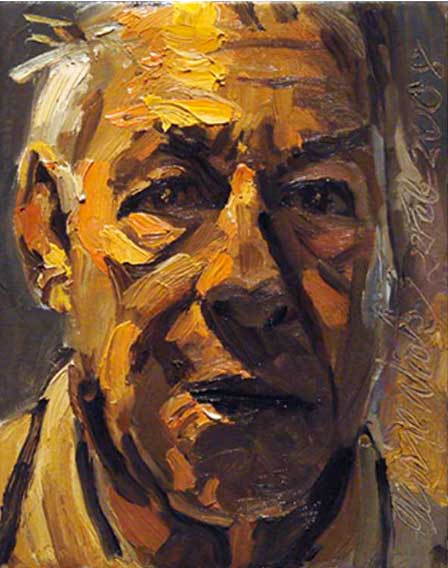
George Nick Self-Portrait, 22 February 2008 10 x 8in oil on linen
Making judgments about appearances involved taking into account not only the relativity of visual phenomena, but the relativity of perception itself. Like Bergson’s concept of time as an ineffable duration (durée)—always mobile and always incomplete—our perceptions, too, we learned, were fluid and mutable. As Nick’s own teacher, Edwin Dickinson, observed with characteristic eloquence: “The seen distortion is what a thought did to the sight.” A color, here, could seem bluer and darker; there, more greenish and light—depending on how we saw it. Paradoxically, Nick would often and loudly assert in the face of such relativism that absolute accuracy and truth were not only demanded by the facts before us, but were always within our reach. “That’s not dark enough,” he would say. “You’re being too protective of your colors. Make it darker.” His next time around the classroom the same poor student might hear: “Your colors aren’t good enough. They don’t have any feeling.”
In time, we too learned to assert our perceptions in the face of this mercurial order. We learned to accept the conditional—embracing it as though it were absolute while acknowledging that its truth was relative. Painting “parallel” to our own shifting experience of what we saw, the images on our canvases came more and more to reflect our individual engagement not with the nameable world of objects and things, but with the less effable, “abstract” world of changing conditions and relationships that we sought truthfully to portray. It all seemed a very honest approach, given the complexity both of seeing and what was seen. Meanwhile, for many of us, the idea of “realism” took on new meaning.
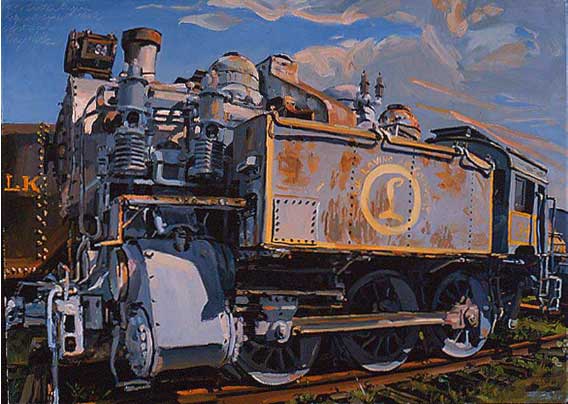
George Nick #34 Switch Engine, 6 October 2000 29 x 40in oil on linen
Nick was constitutionally opposed to our painting the ideas of things, or to painting ideas generally, which he viewed as illustrative acts that compromised painting by making it serve other aims (the aim of showcasing an idea, for example). This notion fit with his belief that painting should speak for itself and through its own terms, which are the terms of its medium. Nick wanted his students to paint and engage directly with the world—no filters, nothing between the artist and reality. It was a highly existential stance, and it raised interesting questions and possibilities about how we might each day experience the world anew, as well as how we might paint it.
What would happen, for example, if one painted as though one were the first man—or the first visitor on earth—standing before nature? Nick would sometimes tell a young painter to paint “more like a Martian,” or he would pepper our class with mantras like: “Forget what you know”; “Paint in the present moment”; “Abstract your eye from memory.” Such prescriptions were not intended to foster some naïve embrace of “the innocent eye.” In Nick’s view, the painter’s vision was never passive. Seeing like this was an act of will, requiring the same rigorous conditioning and discipline that was needed in order to get the truth of our hard-earned perceptions properly translated to the canvas through paint. We all knew, of course, that Nick’s prescriptions were only useful fictions. But the attitude toward painting implied by these and similar proddings was not lost on us.
Since his student days under Dickinson, Nick had evinced in his own work an appreciation for the quicker, reactive kind of painting that Dickinson, alongside his more sustained paintings, had produced. Nick recognized the honesty that such direct translation of visual circumstances could potentially bring to a work. He passed on this appreciation, like family history, to his students. Painting in the ‘here and now’, as if there were no tomorrow, meant expression unmediated by any other agent. In Nick’s view, painting does not need mediation. Any painting adulterated too much by self-consciousness, or by the pre-conceived, or relegated to the subservient role of “conveying an idea,” had already compromised the integrity of one of painting’s most unique gifts: its capacity to express through a language that is uniquely its own. Nick was fond of quoting Stravinsky, as when Stravinsky said, famously: “Music expresses nothing; it expresses itself.” This did not represent, on Nick’s part, a shallow retreat from significance beyond the canvas, but an avid belief in the importance and value of meanings conveyed only by the terms of painting. Living, as we do, in a culture so preoccupied with codes and decoding, Stravinsky’s declaration will no doubt sound outdated to those indoctrinated with post-modernist sensibilities, as will Nick’s parallel convictions about painting. But, for Nick, paintings are not meant to be “read”—they are meant to search, uncover and reveal.
Encouraging us alternately to work at both long- and short-term paintings, Nick wanted us to explore different ways to define and get at the truths we each were seeking. Importantly, he taught us to confront head-on the resistance and difficulty of the oil medium. Nick believed that a painter’s perception of the intransigence of the oil medium was a mirage, and that the artist’s will was all powerful. He was not being Pollyannaish. He knew all too well the rebelliousness of our medium and its opposition to facility. But Nick the teacher was also an artist who, like Degas, relished obstacles and felt alive and engaged only when art was a struggle. He energized our classroom by getting us to believe that the artist’s will was the best means to enable artistic imagination to discover its potential—implying that that potential was itself born of a dialectic involving struggle and artistic desire.
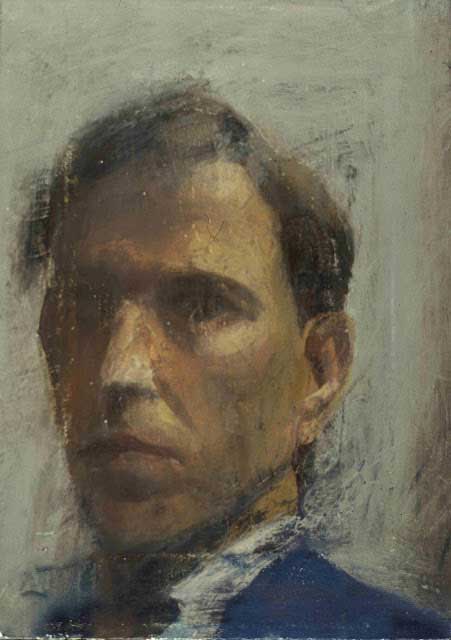
Christopher Chippendale Self Portrait
Each student-artist’s philosophy of painting, Nick understood, would come of its own over time, as would the inflection of personal aesthetics in her or his work and the manifestations of the ideas and feelings underlying them. These individual qualities, Nick believed, must come through painting, through finding their articulation through the irreducible utterances of paint. Nick knew how vital the inner worlds of his students were to their finding meaning in their work. He said he learned to be hands-off regarding these important inner dimensions of his students from Dickinson. He knew how crucial were his students’ personal aesthetics, and he knew how best to respect them: he rarely spoke of them at all.
Once, when I was in the midst of a long struggle involving my own personal aesthetics and the paint on the canvas, I turned to Nick, privately, for some sympathy. I was at wits’ end and morosely dispirited over a painting that was going badly. When I had finished my blubbering, Nick said volubly and in a manner that was matter-of-fact, while looking me straight in the eye: “You ought to be chained to your easel.” Embarrassed by his words and stung deeply as they sunk in, I never forgot them. Yet there was nothing calculated in what he said. It was his honest response—and this was what we had learned always to expect from him. Over time, looking back upon that moment, it came to represent an important turning point in my development: I came to understand how truly difficult painting was, and that if I was going to be a painter, I had best learn that, notwithstanding the trials yet to be endured, there was no giving up.
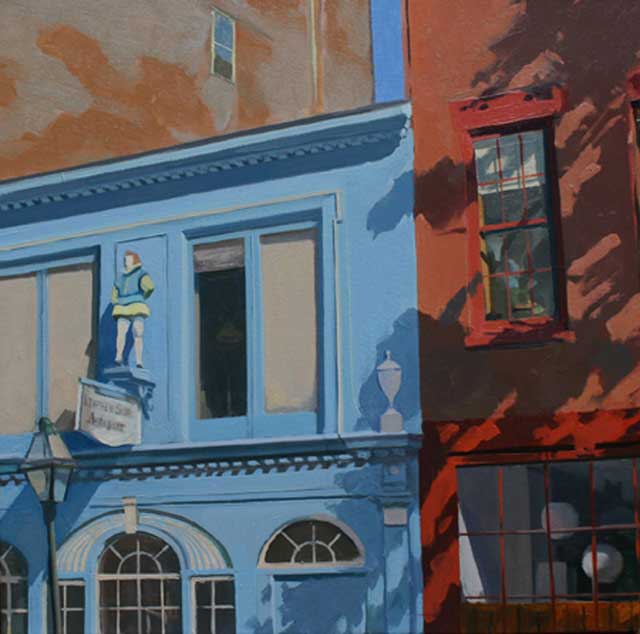
Christopher Chippendale The Mystery of Upstairs Oil on canvas 27″ x 27″, 2009
Like many before me, I had my own naïve and as-yet-to-be-tested ideas about what painting was, or should be, when I arrived in January of 1986 to study Nick’s observational approach to painting. I remember painfully well the blunt trauma brought down upon my precious sensibilities regarding painting when, after assigning the first semester sophomores (of which group I was then one) to their own room away from the upperclassmen working from the live model—and then referring to our collective unit derogatorily as “the Bumblebees” (“I’ll just go see how the Bumblebees are doing,” he would announce loudly while leaving the upperclassmen to check on us)—he set up an ugly old snow-blower on the model stand in front of our disbelieving eyes. Turning to us, he then said, unequivocally: “Use four colors only. And only four values. Apply the paint with your palette knives. And try to make the colors ‘felt’.” He then walked out of the room. If it was blind faith that kept us around after this kind of assault, there was also something more, something momentous that we already sensed about the man. As it turned out, for many of us, our intuitions paid off.
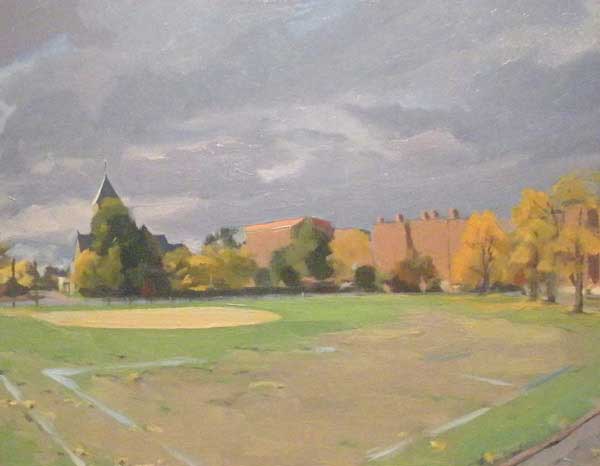
Christopher Chippendale The Cambridge Commons (October) Oil on canvas 20″ x 26″, 2009





Great Post, Larry! I look forward to the book (in mail)!
jlee
Lovely tribute to terrific artist. Wish I had had the benefit of his teaching.
What wonderful tribute to great teacher and dedicated artist. His paintings have a breath of life in them that few others can convey. I had the good fortune of being one George’s students at Mass art in 1969-71. I remember several of the quotes cited above and use them to this day with my art students here in Tokyo. Thank you, George for the wisdom, inspiration and ability to always find something your students’ work that can help them grow as artists and people.
I met George Nick at the Vermont Studio School in the summer of 2006. He was marvelously generous and inspirational!
I first saw a reproduction of a painting by George Nick in an art catalogue. It was of a gas station on a corner and was the most beautifully painted gas station I had ever seen. I was smitten immediately! Reading this wonderful essay has confirmed what I saw with my own eyes having never heard of George Nick. Thank you- thank you. God I’d love to meet this guy. Let us know when he has teaching engagements near Rhode Island where I’m from.